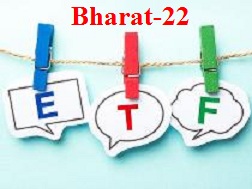On November 13, 2017, Government of India launched New Fund Offer (NFO) for BHARAT-22 Exchange Traded Fund (ETF), through which it is targeting to raise initial amount of about Rs. 8000 crore as a part of disinvestment programme for the current fiscal.
What is Exchange Traded Fund (ETF)?
An exchange-traded fund (ETF) is an investment fund traded on stock exchanges, just like stocks.
- An ETF holds assets such as stocks, commodities, or bonds and tracks an index, such as a stock index or bond index.
- ETFs may be attractive as investments because of their low costs, tax efficiency, and stock-like features.
More information about Bharat-22 Exchange Traded Fund (ETF):
New Fund Offer of Bharat-22 ETF will be open till November 17, 2017, and is being managed by ICICI Prudential Mutual Fund.
- This ETF is a unique blend of shares of key Central Public Sector Enterprises (CPSEs), Public Sector Banks (PSBs) and Government owned shares in blue chip private companies like Larsen & Tubro (L&T), Axis Bank and ITC held under the Specified Undertaking of the Unit Trust of India (SUUTI).
- The ETF features four banking stocks — SBI, Axis Bank, Bank of Baroda and Indian Bank.
- Maharatanas and Navratanas such as Coal India, Power Grid Corporation of India Ltd. (PGCIL), GAIL, National Thermal Power Corporation (NTPC), Oil & Natural Gas Corporation (ONGC), Indian Oil Corporation Ltd., Bharat Petroleum and National Aluminium Company (NALCO) are also the constituents of Bharat-22 ETF.
- Specially created ‘S&P BSE BHARAT-22 INDEX’ is the benchmark index for this ETF.
- It is a broad-based and diversified index as it comprises 22 companies that represent 6 important sectors of the economy – Finance, Industry, Energy, Utilities, Fast Moving Consumer Goods (FMCG) and Basic Materials.
- 39% of the index is in private sector companies while 61% is in government-owned companies.
- The index has single company cap of 15% and a sectoral cap of 20%. This is a prudent risk management measure which prevents concentration exposure on one particular company or sector.
AffairsCloud Recommends Oliveboard Mock Test
AffairsCloud Ebook - Support Us to Grow
Govt Jobs by Category
Bank Jobs Notification


